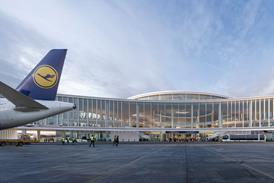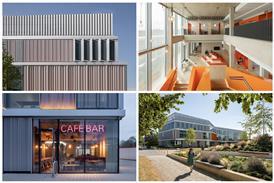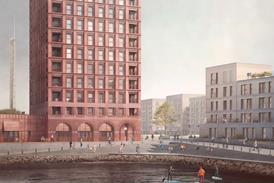David Rudlin tells the story of how a left-wing planner enabled the son of a miner to build Britain’s largest out-of-town shopping centre

In our forthcoming book on high streets, Vicky Payne, Lucy Montague and I tell the stories of one hundred retail centres across the UK. It is based on the idea that the stories of these places can be just as illuminating as the data.
Before Christmas I wrote about the world’s oldest record shop in Cardiff. By contrast this column is about the UK’s largest shopping centre and how a radical left-wing theory enabled it’s development.
The miner’s son in the title was Sir John Hall, who grew up in the pit town of Ashington. He started as a mining surveyor but, after the National Coal Board helped him qualify as a building surveyor, set up his own property business.
Initially he bought and sold houses, before building a small supermarket and getting into retail. On a trip to the US he was impressed by its shopping malls and decided that they would be perfect for the wet and windy northeast of England.
The Non-Plan movement grew out of the anarcho-libertarian movement of the New Left in the 1960s
There was however no way he could get planning permission. In the 1960s there had been a landmark planning ruling against an out-of-town shopping centre at Haydock between Liverpool and Manchester after which the UK set itself against out-of-town malls.
That was until the end of the 1970s when Conservative shadow minister Geoffrey Howe gave a speech at the Waterman’s Arms pub. Surrounded by the dereliction of London’s docks, he quoted the work of a group of counter-cultural architects, planners and journalists; Peter Hall, Cedric Price, Paul Barker and Reiner Banham.
Their “Non-Plan” manifesto published in New Society argued that the “natural desires and spontaneous whims of the population were being repressed by state planning”. It called for a radical experiment to exempt parts of Britain’s inner cities from planning regulations to free them from the heavy hand of state regulation.
Having got to know Professor Sir Peter Hall in his later years, I can tell you he was no neo-liberal. Indeed, at the time he had been a member of the Labour Party and chair of the Fabian Society. The Non-Plan movement grew out of the anarcho-libertarian movement of the New Left in the 1960s. It was based on a mistrust of the state and there is a certain irony that it chimed so well with the free market inclinations of the Conservative government.
Back in Gateshead John Hall had bought a large site, known as the ‘great big clarty field’
In his speech Geoffrey Howe suggested that, rather than invest in declining industrial areas, the government should take a leaf out of the Non-Plan manifesto and designate a series of enterprise zones to lift the shackles off enterprise.
Back in Gateshead John Hall had bought a large site, known as the ‘great big clarty field’, the ash tip of the Dunston power station five miles from the centre of Newcastle. In the budget of 1980 Geoffrey Howe, by now Chancellor of the Exchequer, announced 11 Enterprise Zones. These were in London Docklands, Glasgow, Belfast, Hartlepool, Liverpool, Trafford in Manchester, Wakefield, Swansea, Corby, Dudley and an area of Newcastle/Gateshead including a certain clarty field.
These zones would be free of planning regulations, business rates and capital allowances. They were also exempt from Development Land Tax, industrial training boards and requests from the government for statistical information. It had also been suggested that they be exempt from fire and building regulations, taxi licensing and even laws on sex and racial discrimination but the government stopped short of going this far.
Most enterprise zones excluded retailing from the relaxation of planning controls. The exceptions were Dudley, where two local businessmen built one of the largest retail parks in the country, and Gateshead where John Hall built the Metro Centre without the need for planning permission. By the time it was fully open in 1988, the Metro Centre stretched to two million square feet with 10,000 free parking spaces – the largest mall in the UK until Westfield London opened in 2008.
This radical experiment reminded us that deregulation in planning often has unintended - and sometimes damaging - consequences
The centre included elements that John Hall had seen in the US and would become the template for other regional shopping centres in the UK. It was open and airy, under a glass roof and was built in a slightly kitsch classical style to provide the shopping public with a sense of luxury and escape. By 1990 it was attracting 21 million visitors a year and had become incredibly successful.
It opened the gates to a wave of out-of-town malls. At the time there were plans for up to 50 regional shopping centres, which would have changed the face of retailing in the UK for ever. Only a handful were built including Meadowhall, the Trafford Centre, Cribbs Causeway and Bluewater. Newcastle city centre survived the Metro Centre, although Sheffield was badly hit by Meadowhall, together with many nearby mid-sized towns.
By the 1990s planning policy had once more turned against out-of-town retailing and town centres were saved from further erosion of their economic role. These traditional town centres may have struggled in recent years but had it not been for the planning system, they would have followed the US model and may not have existed at all.
The irony of a left-wing planning professor providing the intellectual cover for the Thatcher government’s neo-liberal economic policies was not lost on Peter Hall. This radical experiment reminded us that deregulation in planning often has unintended - and sometimes damaging - consequences.
Postscript
David Rudlin is director of Urban Design at BDP and visiting professor at Manchester School of Architecture.
High Street: How our town centres can bounce back from the retail crisis will be published by RIBA Publishing in Spring 2023
















1 Readers' comment